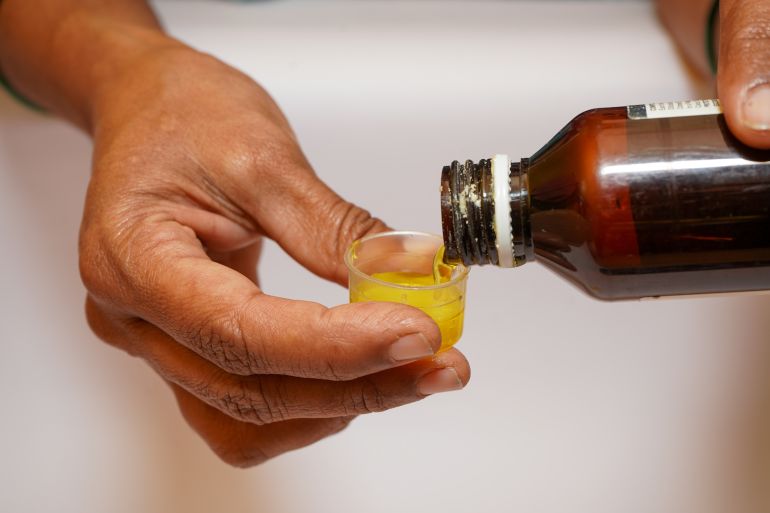India probes possible cough syrup link to deaths of at least nine children – Al Jazeera

Report on Pharmaceutical Contamination Incident in India and its Implications for Sustainable Development Goals
Incident Overview
Summary of Events
An investigation has been launched by India’s federal Ministry of Health and Family Welfare following the deaths of nine children under the age of five in the states of Madhya Pradesh and Rajasthan. The deaths are allegedly linked to the consumption of a contaminated cough syrup, Coldrif, manufactured by Sresan Pharma.
- Product Implicated: Coldrif cough syrup.
- Contaminant Identified: Diethylene glycol (DEG), a toxic industrial solvent, found in levels exceeding permissible limits.
- Fatalities: Nine children, all below five years of age.
- Regulatory Action: The product has been banned in the states of Madhya Pradesh, Tamil Nadu, and Kerala.
Impact on Sustainable Development Goal 3: Good Health and Well-being
This public health crisis directly contravenes the core principles of SDG 3, which aims to ensure healthy lives and promote well-being for all at all ages.
Failure to Protect Child Health (Target 3.2)
The deaths of nine children represent a severe setback for SDG Target 3.2, which calls for an end to preventable deaths of newborns and children under five years of age. The incident underscores a critical failure in the public health safety net designed to protect the most vulnerable populations.
Compromised Access to Safe Medicines (Target 3.8)
The contamination of a common medication undermines SDG Target 3.8, focused on achieving universal health coverage, including access to safe, effective, quality, and affordable essential medicines. The presence of DEG in the syrup highlights a significant lapse in pharmaceutical quality control and manufacturing standards.
Broader SDG Implications
SDG 12: Responsible Consumption and Production
The incident reveals a failure to adhere to the principles of responsible production patterns as outlined in SDG 12.
- The manufacturing of a medicinal product containing a toxic industrial solvent is a direct violation of safe production practices.
- The event points to systemic weaknesses in quality control and assurance within the pharmaceutical supply chain.
- Such failures erode public trust and challenge the sustainability of the national pharmaceutical industry.
SDG 16: Peace, Justice, and Strong Institutions
The response to the crisis and the pre-existing regulatory gaps are directly relevant to SDG 16, which emphasizes the need for effective, accountable, and transparent institutions.
- The federal Ministry of Health and Family Welfare has initiated an investigation into the manufacturer and the contaminated product batch.
- State-level authorities have implemented bans on the product to prevent further harm.
- Inspections have been launched at 19 drug manufacturing facilities across six states to identify and rectify quality control deficiencies.
- This event highlights the urgent need for strengthening regulatory bodies and enforcement mechanisms to ensure drug safety and hold institutions accountable.
Global Context and SDG 17: Partnerships for the Goals
International Ramifications
This incident is not isolated, reflecting a recurring issue with global health implications and underscoring the importance of international cooperation as envisioned in SDG 17.
- Indian-manufactured cough syrups have been linked to child fatalities in other countries, including over 70 deaths in The Gambia in 2022.
- These events necessitate stronger global partnerships and information sharing between national regulators and international bodies like the World Health Organization (WHO).
- Achieving global health security is dependent on robust international cooperation to ensure the integrity of the global pharmaceutical supply chain, a key tenet of SDG 17.
Analysis of Sustainable Development Goals (SDGs) in the Article
-
Which SDGs are addressed or connected to the issues highlighted in the article?
The article highlights issues directly connected to several Sustainable Development Goals. The primary focus is on health and well-being, but it also touches upon responsible production and the role of institutions in ensuring public safety.
- SDG 3: Good Health and Well-being: This is the most prominent SDG addressed. The article’s central theme is the death of children due to contaminated medicine, which is a direct failure to ensure healthy lives and promote well-being.
- SDG 12: Responsible Consumption and Production: The contamination of cough syrup with a toxic industrial chemical, diethylene glycol (DEG), points to failures in production patterns and quality control within the pharmaceutical industry.
- SDG 16: Peace, Justice and Strong Institutions: The article discusses the response of governmental bodies, such as the federal Ministry of Health and state drug regulators, in investigating the incidents, banning products, and inspecting manufacturers. This relates to the effectiveness and accountability of public institutions responsible for health and safety regulations.
-
What specific targets under those SDGs can be identified based on the article’s content?
Based on the specific problems and actions described, several SDG targets can be identified:
- Target 3.2: End preventable deaths of newborns and children under 5 years of age.
The article explicitly states that the investigation is into the deaths of “nine children, all aged below five years.” These deaths, caused by contaminated medicine, are preventable and fall directly under the scope of this target.
- Target 3.8: Achieve universal health coverage, including… access to safe, effective, quality and affordable essential medicines… for all.
The incident demonstrates a critical failure in providing “safe” and “quality” essential medicines. The cough syrup, a common medication, was found to be dangerously contaminated, undermining public trust and access to safe healthcare products.
- Target 12.4: …achieve the environmentally sound management of chemicals and all wastes throughout their life cycle… and significantly reduce their release… to minimize their adverse impacts on human health…
The contamination was caused by “diethylene glycol (DEG),” described as a “toxic substance used in industrial solvents.” Its presence in a pharmaceutical product is a clear failure in the management of chemicals, leading to severe adverse impacts on human health, as evidenced by the children’s deaths.
- Target 16.6: Develop effective, accountable and transparent institutions at all levels.
The response from Indian authorities, including the “investigation… ordered by the federal Ministry of Health and Family Welfare,” the ban on the syrup by three states, and the launch of “inspections of 19 drug manufacturers,” are all actions related to the functioning and accountability of public health institutions tasked with ensuring drug safety.
- Target 3.2: End preventable deaths of newborns and children under 5 years of age.
-
Are there any indicators mentioned or implied in the article that can be used to measure progress towards the identified targets?
The article provides both direct and implied indicators that can be used to measure the status and progress related to the identified targets.
- Indicator for Target 3.2 (Under-5 mortality): The article provides a direct data point for measuring this target: the “deaths of nine children, all aged below five years.” This number contributes to the overall under-5 mortality rate (Indicator 3.2.1) and specifically highlights mortality due to preventable causes like unsafe products.
- Indicator for Target 3.8 (Access to safe medicines): An implied indicator is the quality and safety of pharmaceutical products in the market. The finding that samples “contain DEG beyond the permissible limit” serves as a negative indicator, showing a failure to provide safe medicines. Conversely, actions like product testing and regulatory enforcement can be seen as process indicators for ensuring medicine quality.
- Indicator for Target 12.4 (Chemical management): The level of contamination itself is a key indicator. The statement that the syrup contained “diethylene glycol (DEG) exceeding permissible limits” is a direct measurement against a safety standard. The number of such contamination incidents serves as an indicator of failures in the sound management of chemicals in production processes.
- Indicator for Target 16.6 (Effective institutions): The article mentions several actions that can be quantified as indicators of institutional effectiveness. These include the number of investigations launched, the number of products banned, and the number of “inspections of 19 drug manufacturers across six states.” These actions demonstrate the regulatory response to a public health crisis.
SDGs, Targets, and Indicators Summary
| SDGs | Targets | Indicators Identified in the Article |
|---|---|---|
| SDG 3: Good Health and Well-being | Target 3.2: End preventable deaths of newborns and children under 5 years of age. | The specific number of child fatalities: “deaths of nine children, all aged below five years.” |
| SDG 3: Good Health and Well-being | Target 3.8: Achieve universal health coverage, including access to safe, effective, quality and affordable essential medicines. | The presence of contaminated medicine on the market, evidenced by the syrup containing DEG “beyond the permissible limit.” |
| SDG 12: Responsible Consumption and Production | Target 12.4: Achieve the environmentally sound management of chemicals… to minimize their adverse impacts on human health. | The specific contaminant identified: “diethylene glycol (DEG),” a toxic industrial substance found in a consumer product. |
| SDG 16: Peace, Justice and Strong Institutions | Target 16.6: Develop effective, accountable and transparent institutions at all levels. | Regulatory actions taken by institutions: investigations ordered, product sales banned, and “inspections of 19 drug manufacturers.” |
Source: aljazeera.com
What is Your Reaction?
 Like
0
Like
0
 Dislike
0
Dislike
0
 Love
0
Love
0
 Funny
0
Funny
0
 Angry
0
Angry
0
 Sad
0
Sad
0
 Wow
0
Wow
0














































.jpg.webp?itok=0ZsAnae9#)







:focal(1500,1000)/https://media.globalcitizen.org/a6/9a/a69a4720-d8a1-4715-b596-18738d03c05c/rotary_polio_hero_image.jpg?#)

/countries/sri-lanka/photo-credit---dmc-sri-lanka.tmb-1200v.jpg?sfvrsn=dc298bcc_1#)



















